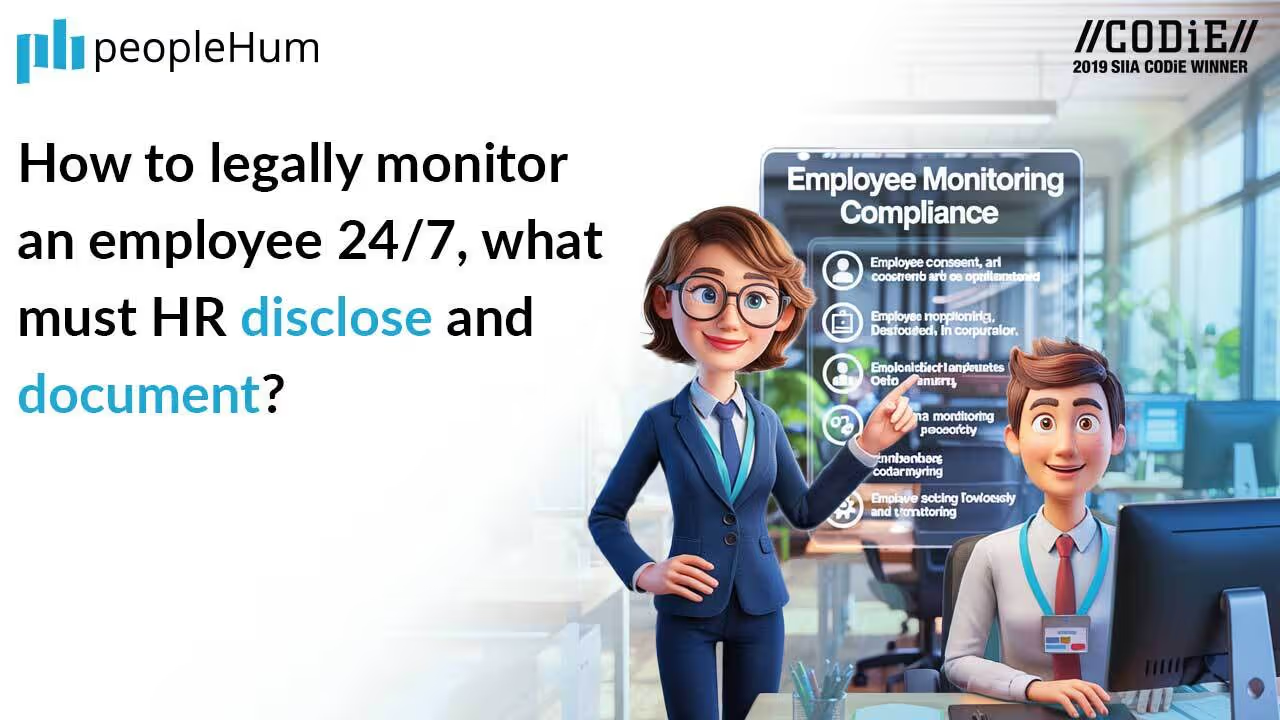The digital age has made monitoring employee performance and security easier than ever, but it also increases the risk of invading privacy. For HR leaders, the goal isn't to watch every move, but to protect company assets and ensure fairness. Achieving this requires a clear policy, open communication, and the right tools.
The ability to monitor is strongest when employees are using company-owned devices, systems, and accounts, and it’s limited to work-related activities. You cannot legally monitor every single aspect of an employee's life, especially outside of work hours, unless there are very specific and documented security concerns. To stay on the right side of the law, you must focus on what you monitor and why.
What are the legal points HR leaders need to consider before deciding to monitor employees 24/7?
Know your monitoring boundaries
Monitoring should be limited to professional activities. This means focusing on company devices, systems, and accounts. The monitoring should not spill over into personal spaces or devices unless there is a clear, work-related reason and the employee is fully aware and has consented.
- Transparency is key: Ensure that employees are fully informed about the monitoring methods and the purpose behind it. Laws like the GDPR require that employees know what data is being collected and how it will be used.
- Consent: Depending on the jurisdiction, obtaining employee consent may be mandatory. This could include explicit consent via contracts or company policies.
What should HR disclose to employees about monitoring?
1. The type of monitoring
HR should be clear and upfront about the methods and extent of monitoring. This is essential for building trust and ensuring compliance with legal standards. The primary points to disclose include:
- What to state: Tell employees if you monitor internet browsing history, email communications, phone usage on company devices, or use location tracking (if applicable to their role, like a delivery driver).
- Why it matters: Employees must understand the business reason behind the monitoring. Is it for security? To measure productivity? To ensure compliance with specific industry rules? Clear reasoning builds transparency.
2. Disclose how monitoring takes place
Employees need to understand the boundaries and methods of surveillance so they can adjust their work habits accordingly.
- Scope of surveillance: Clarify the time frame. Does monitoring apply only during official work hours, or does it cover an employee's use of a company-issued laptop after hours (a distinction that is very important)?
- Methods of collection: Be upfront about the tools used. State whether data is collected through software, security cameras in common areas, or tracking devices in company vehicles.
How HR must document Monitoring Protecting the Company
Proper documentation is your shield against potential legal claims. It proves you acted responsibly, followed your own policies, and respected employee rights.
1. Create a mandatory clear monitoring policy
This policy is the central document that lays out the rules for everyone.
- Policy outline: Include every type of monitoring you use, how often it occurs, and the clear business reasons for it.
- Employee acknowledgment: Every employee must officially sign off on this policy. This creates a clear record that they were informed and agreed to the practices, eliminating all ambiguity.
- Regular review: Monitor technology and privacy laws change constantly. Update your policy regularly to reflect new tools or legal requirements.
2. Keep accurate records of consent
Don't rely on casual conversation. You need proof that the employee knows about the monitoring and agrees to it.
- Written consent: Get explicit written consent from employees. This should be a formal, separate document or a key part of their employment contract that they sign.
- Record all activity: Maintain records of the data collected, the purpose of collection, and how long the data is stored. This clear audit trail is essential if you ever need to legally justify your monitoring actions.
How to monitor without destroying morale?
Excessive surveillance can be a quick path to a hostile work environment, burnout, and high turnover. Ethical monitoring focuses on support and fairness, not simply catching people doing something wrong.
1. Strike a balance: Monitoring and autonomy
Monitoring should be about ensuring productivity and security, not controlling personal time.
- Respecting personal space: Avoid monitoring employees during their off-hours unless absolutely necessary. Focus on work hours and work-related activities.
- Communication: Ensure employees are regularly informed about why and how monitoring occurs, reinforcing the idea that it's for productivity, security, and fairness, not to invade privacy.
- Use technology wisely: Rather than continuous 24/7 monitoring, use systems that send alerts only when necessary, thus reducing the feeling of constant surveillance.
2. Move beyond micromanagement metrics
Ethical monitoring uses data to support employee growth and reward value, rather than just tracking clicks and hours.
- Focus on skills and growth: Use tools like skills-based ladders to track an employee's development and progress toward defined goals. This shifts the focus from "time logged" to "competency and results."
- Invisible contribution scoring: Look for technology that helps track value-based contributions, such as collaboration, mentorship, and innovation, which often happen "invisibly" but are critical to team success. Progression plans should be based on value delivered, not just visibility at a keyboard.
What tools can help monitor employees legally and ethically?
HR tech platforms have advanced significantly, providing various tools to monitor employees in a compliant and non-invasive way. Here’s how to integrate technology ethically:
- System alerts: Instead of recording everything 24/7, use systems that are designed to send alerts only when certain, pre-defined security or policy-violating activities occur. This reduces the feeling of constant surveillance.
- peopleHum’s automated progression nudges: Platforms like peopleHum can help automate the tracking of employee progress without the need for intrusive monitoring, promoting growth through visible, competency-based ladders.
Conclusion: Ethical monitoring is possible with transparency and tools
Employee monitoring doesn’t have to feel like an infringement on privacy. By adhering to legal guidelines, being transparent, and using ethical tools, HR can monitor employees effectively without damaging trust or morale. As HR leaders, it's essential to constantly evaluate your strategies, ensure all documentation is clear, and remember that the goal of monitoring should always be for the benefit of both the employee and the company.
For a more seamless, legally compliant approach to employee monitoring, consider integrating peopleHum’s skills profiles and automated progression nudges to track employee growth and contributions in a non-invasive way.















































